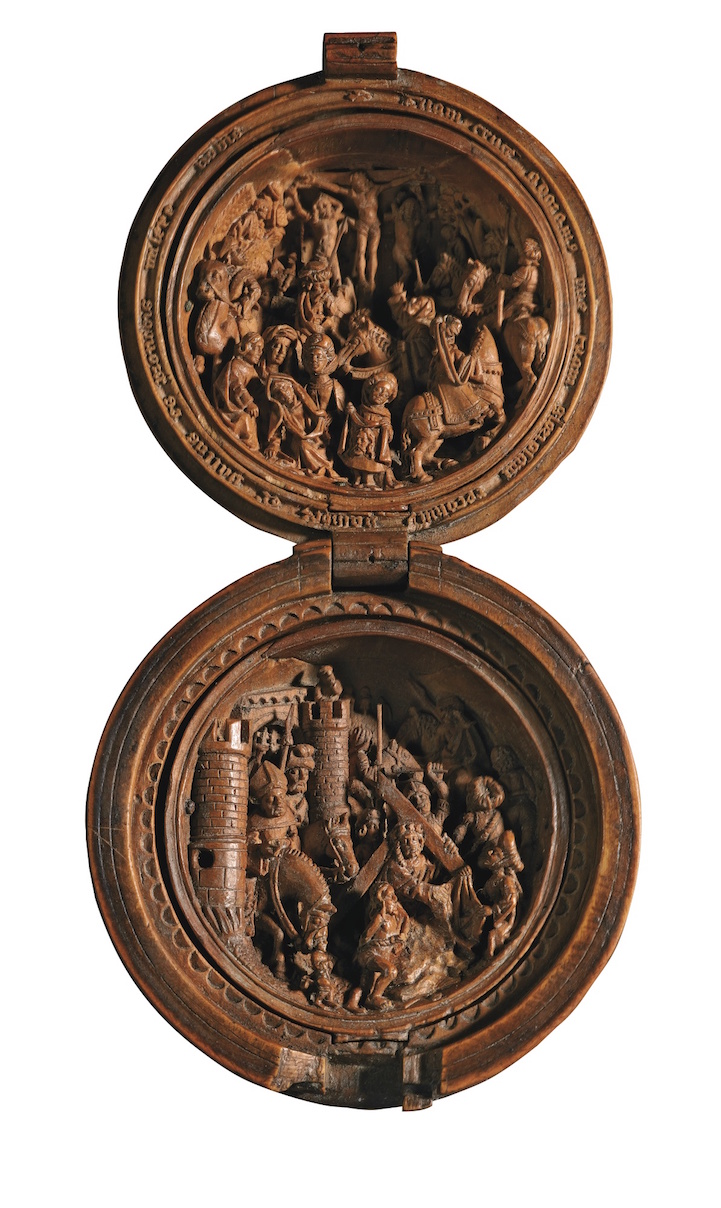Properzia's life was filled with opportunity, drama, acclaim and despair. She was born in Bologna in 1490 to a notary named Giovanni Martino Rossi da Modena. As a woman of the Renaissance, Properzia was well educated. She studied painting, music, dance, poetry, and classical literature. Later she studied drawing and engraving at the University of Bologna under Marcantonio Raimondi. None of these pursuits caught her attention until one day she decided to try her hand at sculpture. She began creating small but intricate works of art on apricot, peach, and cherry stones. The subjects of these tiny carvings were often religious; the most famous was her "Crucifixion". The Crucifixion is carved in a peach pit. Yes, you read that correctly - with the peach pit split open and the scenes carved inside.
 |
| Properzia's Passion Pit |
Well Giorgio, Properzia did attempt sculpting. Not only did she attempt it, she stood toe to toe with her male counterparts. She was commissioned to decorate the altar of Santa Maria del Baraccano in Bologna and won a competition to produce marble sculpture for the Basilica of San Petronio in Bologna.
 |
| Basilica of San Petronio, Bologna |
It was while working on the Basillica that Properzia became acquainted with Anton Galeazzo Malvasia. Scholars differ on the nature of their relationship. Some say it was definitely a romance, while others suggest that Malvasia was more of a friend and patron.
Properzia found herself in a bit of trouble that involved Malvasia. There was a merchant of the city that lived next to Properzia and their gardens joined. Somehow the merchants garden sustained damage, and the merchant filed charges against Properzia. In the charge he refers to Properzia as Malvasia's mistress; Malvasia, of course denied the charge. Apparently all parties to the suit came to a amicable resolution, as the charges were soon dropped. Unfortunatley, because the charge was in writing, and notarized, Properzia has gone down in history as Malvasia's mistress, whether it is true or not.
On another occasion Properzia got into an altercation with a painter, Vincenzo Miola. Miola claimed that Properzia and another artist, Domenicno Francia, came to his home and attacked him. Miola claimed that during the attack Properzia scratched his face. This incident was also resolved quickly. After the initial complaint there are no other records of the proceedings. Some writers have suggested that Miola resented Properzi's talent, and was acting out of jealously.
By 1530 Properzia is found to be residing in the Ospedale della Morte, (Hospital of Death), gravely ill. It is not clear what her aliment was, although the Ospedale was noted for treating victims of the plague. She passed away in February of that year.
Properzia de' Rossi was described by her contemporaries as brilliant, fickle and untamable. Hummm...how else would a badass artist be described?
++++++++++++++++++++++++++++++++++++++++++
Donati, Silvia. 8 Things to Know about Bologna’s Basilica of San Petronio.
https://bolognauncovered.com/2016/08/18/8-things-to-know-about-bolognas-basilica-of-san-petronio/
Donati, Silvia. Bologna Uncovered. Three Notable Women Artists from Bologna. https://bolognauncovered.com/2017/03/04/three-notable-women-artists-from-bologna/
Frank, Priscilla. The Huffington Post. These Are The Revolutionary Women Artists Of The 15th Through 19th Centuries.
Ragg, Laura M. The women artists of Bologna.
https://babel.hathitrust.org/cgi/pt?id=uc1.32106007700112&view=1up&seq=214
No comments:
Post a Comment